Marie Connor
Marie Connor Leighton (4 February 1867 – 28 January 1941) was a prolific author of serial fiction and melodramatic novels. She married fellow writer Robert Leighton and her most famous work Convict 99 was written jointly with him. However her writing income was far in excess of his.[1]:20
Marie Connor | |
|---|---|
| Born | 4 February 1867 7 York Road, Bristol, Gloucestershire, England |
| Died | 28 January 1941 (aged 73) Aylesbury, Buckinghamshire, England |
| Nationality | English |
| Other names | Mrs Leighton, Marie Connor Leighton |
| Occupation | Author |
| Years active | – |
| Known for | Melodramatic novels |
Notable work | Convict 99 |
Paternity and birth
While most sources[2][3][4]:238[5]:369 describe Connor as the daughter of James Nenon Alexander Connor (1835 – 21 June 1897)[6] this is not accurate as Marie's mother Elizabeth Ann Treglown[note 1] (c. 1842 – 16 April 1908)[note 2] had a different husband when Connor was born and only married James Nenon Alexander Connor in the first quarter of 1869,[8][9] when Marie Connor was already two years old.
While Elizabeth Anne Treglown was living at Camborne, Cornwall, with her parents, Josiah Henry Harris (c. 1848 – 18 April 1917), a newspaper reporter, visited her and courted her. He was accepted as her fiancé by her family and the couple had been engaged for some time.[10][11] In April 1865, the pair travelled to Paris, and were married there, on 6 April 1865, at the English Episcopal Church, in the presence of the British Ambassador.[12] The marriage had been a surprise to the family, and Harris had announced it by letter[11].
The new couple returned to England, and lived with Elizabeth's parents in Camborne, but after a week, Harris walked out, without saying where he was going. Elizabeth found that he had gone to Bristol and joined him there, but after a time, he again left, this time for Torquay. She joined him in Torquay, but after a time, he again deserted her.[11] By now, her family had moved to Montpelier in Bristol, where Elizabeth gave birth to her daughter at 7 York Road, on 4 February 1867,[13] initially registered as Martha Annie, but later known as Marie.[note 3] Elizabeth registered the birth at Clifton on 13 February 1867. Elizabeth was running a school in Montpelier with her sisters Mary Ann (c. 1851 August 1913)[14]and Ellen (c. 1845 – ) while living with her mother.
Josiah seemed fond of the child, caressed it, and treated it as his own.[13] However, after Josiah had again failed in his promises of support for his wife and child, they entered the Workhouse at Clifton, Bristol, on 30 April 1867.[11] The parish authorities, who were responsible for the Workhouse, sought a warrant to arrest Harris for failing to support his wife. Josiah was arrested at Merthyr in South Wales[13] where he worked for The Merthyr Telegraph.[11] He was tried on 9 May 1867 at Bristol Police Court.[10]
Josiah's defence was that he was not liable for maintenance as the couple were not legally married. There was some discussion of this, and the court held, that until a superior court determined that there was no marriage, Josiah was liable. Josiah met with the parish authorities and came to an agreement to pay maintenance. The case was suspended for a month to ensure that he followed through on this promise. It was understood that proceedings to set aside the marriage would be taken in another court.[11][note 4]
In the first quarter of 1869, Elizabeth married widower James Nenon Connor in Kensington.[8][9]. James was a widower, his first wife Eziza Jones (c. 1828 – May 1864) had died five years earlier. Elizabeth described herself as a widow on the marriage certificate.[16] They had one child themselves, Valentine Alexander Nenon Connor (5 June 1875 – 10 May 1927), who emigrated to Canada and worked an engineer there before dying of stomach cancer and pneumonia in Toronto.[17]
Early life
Her step-father had sold his commission in the 87th (Royal Irish Fusiliers) Regiment of Foot and so lost his pension, to that the family lived a hand to mouth existence, living the high life when in funds and hiding out in a small house in St John's Wood when creditors became too insistent.[1]:26
Clare Leighton's biography of Connor states that Connor had a strange upbringing. Neither her mother or father had much interest in her and she was left to her own devices. She copied an entire novel by hand and sent it to a London publisher, who recognised it, and was so puzzled by the childish handwriting that he visited to find out who was responsible.[1]:194 Her next project was writing names and random from a street directory and sending anonymous letters, warning the recipients that their wives or husbands were being unfaithful with people whose names and addresses she had also picked at random.[1]:195
Clare Leighton also related what Connor told her children about her first love affair. When she was ten, Connor fell in love with a window-cleaner, a married father of eight. Their correspondence was discovered and the window cleaner threatened with the law. Connor's parents packed her off to a convent in France where she fell in love with the Mother Superior and the Priest and became a devout Catholic for the rest of her life.[1]:39
After returning from France, Connor got stage-struck, falling in love with the actor Wilson Barrett (1846 – 1904), and writing poems inspired by him. Her parents decided that the only cure was to give her a taste of the stage, so she went on tour with Barrett, chaperoned by one of her maternal aunts. The experience cured her of her love of the theatre.[1]:195
Early writing
Connor published her first novel Beauty's Queen, a three-volume melodrama,[18][19][20] in 1884 when she was 17.[21]The Graphic, after noting that the novel "contains some very remarkable incidents indeed" concluded by saying "The novel is tragical to the highest pitch. All the characters of any consequence are left dead except one little boy, who, it is cordially to be hoped, grows up to meet with more ordinary experiences. The story is altogether ridiculously impossible, and is told in a style of sentimental exaggeration to which no description can do any sort of justice."[22] Sutherland calls this book "An extraordinary mishmash of romantic and religious passion" and said that "it provoked most reviewers to sarcastic drollery", but that "women readers liked it."[5]:369
Marriage and children
Connor quickly followed up with another and had published five novels before her marriage to Robert Leighton (5 June 1858 – 11 May 1934). Born in Scotland but growing up in Liverpool, Leighton moved to London in 1879 and began working for Young Folks magazine as an assistant editor. Leighton was the editor from 1884 to 1885. Connor was a contributor to the magazine. In 1886 Leighton left Little Folks to move to the Bristol Observer, but returned to London in 1887.[23]
Kemp and Mitchell state that the Connor and Leighton eloped to Scotland,[4]:238 but the UK marriage records show that they got married in Marylebone, London in the first quarter of 1889.[24][25] It is clear that they did elope. Connor's mother traced her to a hotel in Fleet Street, and was only placated when couple were able to show her their marriage certificate.[26]
The family lived at 'Vallombrosa' at 40 Abbey Road, St John's Wood, London, where they led a chaotic bohemian existence. Every summer they migrated to a turreted seaside cliff-top villa at Lowestoft in Suffolk.[27]
Connor and her husband had four children:
- Their first child was accidentally smothered in infancy by a nurse.[28]
- Roland Aubrey Leighton (27 March 1895 – 23 December 1915), a poet who was killed in the First World War. He was Vera Brittain's fiancé and features largely in Testament of Youth, the first instalment of her memoirs. He was his mother's favourite. "He is the only one of my children who is beautiful enough to be worth dressing" her daughter reports her as saying.[1]:203 His mother's love for him "stopped just short of idolatry".[28] Marie was devastated when Roland was killed and published an anonymous memoir of him as Boy of My Heart in 1916.
- Clare Leighton[note 5] (12 April 1898 – 4 November 1989), a writer and artist. She wrote several novels as well as the biography of her mother, and was a noted wood engraver. Connor had been dismissive of Clare's looks, ambitions and talents.[30]
- Evelyn Ivor Robert Leighton (31 May 1901 – 21 October 1969) was destined from boyhood for the Navy.[1]:193 He joined the navy on 15 January 1915, and remained in the Navy after the Great War, being posted to the Royal Australian Navy for a while, and marrying an English bride while he was there.[31]
Works
The following is a list, principally drawn from the Jisc Library Hub Discover collated catalogue.[note 6] One title not listed on the Jisc catalogues was found in the list of titles on Holland's blog about Connor.[16] The notes indicate if and where online copies of the texts can be found.
| No | Year | Title | Publisher | Pages | Notes |
|---|---|---|---|---|---|
| 1 | 1884 | Beauty's Queen. A romance, etc | F. V. White & Co., London | 3 vols., 8º | [note 7] |
| 2 | 1885 | A morganatic marriage | F. V. White & Co., London | 3 vols., 8º | [note 8] |
| 3 | 1886 | Two Black Pearls. A novel | F. V. White & Co., London | 190 p., 8º | |
| 4 | 1887 | Sweet Magdalen. Only a love story, etc | F. V. White & Co., London | 3 vols., 8º | [note 9] |
| 5 | 1888 | Husband and Wife. A novel, etc | F. V. White & Co., London | 3 vols., 8º | [note 10] |
| 6 | 1889 | The Triumph of Manhood | Chapman & Hall, London | 3 vols., 8º | FRv[note 11] |
| 7 | 1891 | The Lady of Balmerino. A romance of the Grampians, etc | Ward Lock & Co, London | 3 vol., 8º. | [note 12] |
| 8 | 1893 | The Heart's Awakening. A novel | Chapman & Hall, London | 3 vols., 8º | [note 13] |
| 9 | 1897 | The Red-Painted Box. Being the narrative of a curious experience in the life of the Reverend Mark Bessemer | John Macqueen, London | v. 238 p., 8º | [note 14] |
| 10 | 1898 | Convict 99 : a true story of penal servitude | Grant Richards, London | vi, 316 p., 8 fp ill., 19 cm. | [note 15] |
| 11 | 1898 | The harvest of sin | James Bowder, London | 126 p., 2 ill., 22 cm. | |
| 12 | 1899 | Michael Dred, detective: the unravelling of a mystery of twenty years | Grant Richards, London | 328 p., 8 ill., 8º | [note 16] |
| 13 | 1900 | A Napoleon of the press | Hodder & Stoughton, London | viii, 312 p., 23 cm. | [note 17] |
| 14 | 1901 | In the Shadow of Guilt. A novel | Grant Richards, London | vi. 407 p., 8º | [note 18] |
| 15 | 1903 | In God's Good Time | Grant Richards, London | viii. 510 p., 8º | |
| 16 | 1904 | The Amazing Verdict | Grant Richards, London | 468 p., 8º | |
| 17 | 1906 | Sealed Lips | Ward Lock & Co, London | 368 p., 8º | [note 19] |
| 18 | 1907 | Her Ladyship's Silence | Cassell's, London | vii. 371 p., 8º | [note 20] |
| 19 | 1908 | Put Yourself in Her Place | Ward Lock & Co, London | 347 p., 8º | [note 21] |
| 20 | 1909 | “Money.” | Ward Lock & Co, London | 383 p., 8º | |
| 21 | 1909 | An Eye for an Eye | Ward Lock & Co, London | 378 p., 8º | |
| 22 | 1909 | Deep waters | Ward Lock & Co, London | 414 p., 1 ill., 20 cm. | |
| 23 | 1910 | Convict 413 L | Ward Lock & Co, London | 319 p., 8º | |
| 24 | 1910 | Joan Mar, Detective | Ward Lock & Co, London | 306 p., 8º | |
| 25 | 1910 | Justice! | Ward Lock & Co, London | 303, 16 p., 1 ill., 20 cm. | |
| 26 | 1911 | Builders of Ships | Ward Lock & Co, London | 304 p., 8º | |
| 27 | 1911 | Greed | Ward Lock & Co, London | 320 p., 8º | |
| 28 | 1911 | The Bride of Dutton Market | Ward Lock & Co, London | 320 p., 8º | |
| 29 | 1912 | Her marriage lines | Ward Lock & Co, London | 320 p., col. fs, 8º. | |
| 30 | 1912 | The Missing Miss Randolph | Ward Lock & Co, London | 309 p., 8º | |
| 31 | 1912 | The Triangle | Ward Lock & Co, London | 319 p., 8º | |
| 32 | 1913 | Black Silence | Ward Lock & Co, London | 347 p., 8º | |
| 33 | 1913 | Ducks and Drakes | Ward Lock & Co, London | 320 p., 8º | |
| 34 | 1913 | Her convict husband | Ward Lock & Co, London | 320 p., fs, 8º. | |
| 35 | 1914 | Under the Broad Arrow | Hodder & Stoughton, London | 126 p., 8º | [note 22] |
| 36 | 1914 | Geraldine Walton - woman! | Ward Lock & Co, London | 319 p., fs, 8º. | |
| 37 | 1914 | The Silver Stair | Ward Lock & Co, London | 352 p., 8º | |
| 38 | 1914 | The way of sinners | Ward Lock & Co, London | 320 p., fs, 8º. | |
| 39 | 1915 | The Fires of Love | Ward Lock & Co, London | 320 p., 8º | |
| 40 | 1915 | The Gates of Sorrow | Ward Lock & Co, London | 320 p., 8º | |
| 41 | 1916 | A Marked Woman | Hodder & Stoughton, London | viii, 294 p., 8º | |
| 42 | 1916 | Dark peril | Hodder & Stoughton, London | 285 p., 20 cm. | |
| 43 | 1916 | Boy of my heart | Hodder & Stoughton, London | 221 p. ; | [note 23] |
| 44 | 1916 | In the grip of a lie | John Long, London | 320 p., 20 cm. | |
| 45 | 1916 | The Man who knew all | John Long, London | 319 p., 8º | |
| 46 | 1916 | The Mystery of the Three Fingers | John Long, London | 320 p., 8º | |
| 47 | 1916 | The Story of a Great Sin | Ward Lock & Co, London | 318 p., 8º | |
| 48 | 1916 | Human nature | Ward Lock & Co, London | 315 p., 1 ill., 19 cm. | |
| 49 | 1917 | The Baked Bread, A Novel | Hodder & Stoughton, London | 294 p., 8º | |
| 50 | 1917 | The shame of silence | John Long, London | 318 p., 8º. | |
| 51 | 1917 | Every Man has his Price | Ward Lock & Co, London | 304 p., 8º | |
| 52 | 1917 | Vengeance is Mine | Ward Lock & Co, London | 320 p., 8º | [note 24] |
| 53 | 1918 | Verses of a V. A. D | E. MacDonald Ltd., London | 3 p.l., 9-46 p., 18 cm. | [note 25] |
| 54 | 1918 | Hidden Hands | George Newnes, London | 284 p., 8º | |
| 55 | 1918 | Letters of an expectant grandmother | Hodder & Stoughton, London | xviii, 298, 1 p., 19 cm. | [note 26] |
| 56 | 1918 | Guilty or innocent? | Ward Lock & Co, London | 300 p., fs, 8º. | |
| 57 | 1918 | The Duchess Grace | Ward Lock & Co, London | 303 p., 8º | |
| 58 | 1918 | The hand of the unseen : a romance of real life | Ward Lock & Co, London | 317 p., fs, 8º. | |
| 59 | 1919 | Lucile Dare, Detective | Ward Lock & Co, London | 320 p., 8º | |
| 60 | 1919 | Red Gold | Ward Lock & Co, London | 314 p., 8º | |
| 61 | 1920 | The Girl of the Yellow Diamonds | C. Arthur Pearson, London | 253 p., 8º | |
| 62 | 1920 | The opal heart | Ward Lock & Co, London | pp. 309. 8º. | |
| 63 | 1920 | Convict 100 | Ward Lock & Co, London | 313 p., (8º) | |
| 64 | 1921 | The Stolen Honeymoon | Odhams Press, London | 178 p., 8º | |
| 65 | 1921 | Her fate and his | Ward Lock & Co, London | 303 p., 8º. | |
| 66 | 1921 | The Silent Clue | Ward Lock & Co, London | 301 p., (8º) | |
| 67 | 1922 | Was she worth it? | Aldine Publishing Co., London | 8º | [note 27] |
| 68 | 1922 | For Love or Money | Ward Lock & Co, London | 303 p., 8º | |
| 69 | 1929 | Who Killed Lord Luxmore? etc | C. Arthur Pearson, London | 126 p., 8º | [note 28] |
| 70 | 1930 | The Torry diamonds mystery | Pearson, London | [note 29] | |
| 71 | 1933 | The Woman Bars the Way | Gramol Publications, London | 8º | [note 30] |
| 72 | 1936 | The Money Spider | Mellifont Press, London | 160 p., 8º | |
| 73 | 1937 | In the Plotter's Web | Mellifont Press, London | 160 p., 8º | |
| 74 | 1937 | The Silence of Dr. Duveen, etc | Mellifont Press, London | 160 p., 8º |
Convict 99
Connor continued to churn out novels after her marriage, writing four in total with Leighton, including her most successful work Convict 99. A true story of penal servitude. Sutherland describes this as: "a powerful anti-prison tract which became their best-known work. It has a highly sensational plot in which the hero, Laurence Gray, is framed by a rival in love on false charges of embezzlement and murder. Sent to Grimley Prison as Convict 99 on a life sentence, Laurence suffers various indignities before escaping and proving his innocence. The force of the book lies in its graphic and credible depictions of life in jail (particularly the part played by corporal punishment, or the ‘cat’)."[5]:370
The story was published first as a serial in Answers one of the publications produced by Alfred Harmsworth (1865 – 1922),[note 31] for whom both Connor and Leighton worked. It was published by Grant Richards in London. Quoting Grant Richards, the head of that publishing house, Kemp and Mitchell say that Convict 99 was hugely successful as a serial and was used time and again in different papers, but that it never attract as large a public in book form. Kemp and Mill also say that Convict 99 was Connor's greatest success.[4]:238
Few of Connor's novels were illustrated, and even those which had any illustration usually only had a front-piece. This was normal for novels intended for adults. However Convict 99, like the first three books jointly written with Leighton, was illustrated.[note 32] The eight illustrations below were made by Stanley L. Wood (1866-1928), and are from the online copy at The British Library.[51]
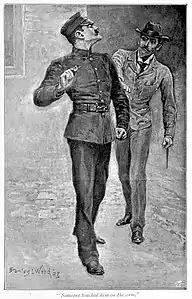 Page 076
Page 076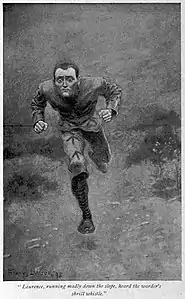 Page 123
Page 123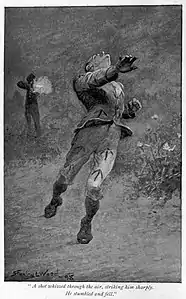 Page 124
Page 124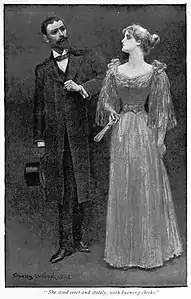 Page 152
Page 152 Page 214
Page 214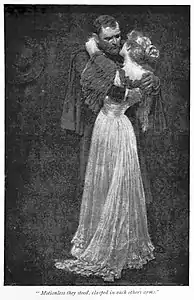 Page 232
Page 232 Page 252
Page 252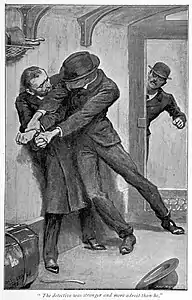 Page 278
Page 278
Later life
Clare Leighton says of her mother that "all men fell in love with her". During her childhood, she relates, there were three men who, with her father, were in love with her mother. Roland called them "Mother's Old Men".[1]:39
From 1891 both Connor and Leighton worked for Alfred Harmsworth, he as an editor, and she as a writer of serial fiction. Harmsworth put his editors in their place when she was pregnant, and they were worried about a delayed installment, telling them that Connor would go on just the same even if she were about to give birth to triplets the next day.[1]:5 Many of Connor's stories were, like Convict 99 serialised first in Harmsworth's Answers. [54]
From 1896 Connor and Leighton were writing almost exclusively for Harmsworth's Daily Mail.[5]:370 Connor continued to produce "potboiling crime stories" sometimes include female heroines.[4]:238 The Times said that her stories were "of the crude, rapidly-moving type, that a pre-cinema public read with approval and delight".[3] Connor published her last novel in 1937, but in practical terms she had given up all serious writing in the 1920s.[5]:370
Connor dies in hospital in Aylsbury, on 28 January 1941.[3] Leighton had died seven years earlier. Mark Bostridge says that Connor "was the archetypal romantic novelist", that she was eccentric and larger than life.[27] Perhaps the best summary comes from the sub-title of her daughter's biography, Connor was an invincible Edwardian.
Notes
- Sometimes written as Treglowan or even Trelawny or Trelawney.
- Elizabeth Ann Treglowan's birth date is uncertain as her implied year of birth differs between census returns.[7]
- Any
- It is not clear is any further action was taken to put aside the marriage, or to determine its legality. The 1911 census return shows that Josiah married again (c.1874). He wrote about the founder of Sunday schools, about the West Country and at least eleven works of fiction, which Kemp and Mitchell call "undistinguished and amateurish".[4]:176 Josiah took his own life in 1917.[15]
- Baptised Clare Marie Veronica Leighton on 26 May 1898,[29] she was also known as Clare Ellaline Hope Leighton and Clare Veronica Hope Leighton
- Library Hub Discover is a database collating 161 UK and Irish academic, national & specialist library catalogues.
- Online at The British Library in three Volumes: Vol.1,[18] Vol.2,[19] Vol.3.[20]
- Online at The British Library in three Volumes: Vol.1,[32] Vol.2,[33] Vol.3.[34]
- Online at The British Library in three Volumes: Vol.1,[35] Vol.2,[36] Vol.3.[37]
- Online at The British Library in three Volumes: Vol.1,[38] Vol.2,[39] Vol.3.[40]
- Online at The British Library in three Volumes: Vol.1,[41] Vol.2,[42] Vol.3.[43]
- Online at The British Library in three Volumes: Vol.1,[44] Vol.2,[45] Vol.3.[46]
- Online at The British Library in three Volumes: Vol.1,[47] Vol.2,[48] Vol.3[49].
- Online at The British Library[50]
- Written with Robert Leighton. Eight full page illustrations by Stanley L. Wood. Online at The British Library[51] and Hathi Trust.
- Not in the Jisc catalogues. Written with Robert Leighton. Said to be the first story in which the detective turns out to be the murderer.[52] Eight Illustrations.
- A novel featuring Lord Northcliffe (1865 – 1922) for whom Connor and her Husband did most of their work.[4]:238
- Written with Robert Leighton. With illustrations by F. C. Luckhurst. Reissued as a Daily Mail sixpenny novel. The British Library Catalogue entry suggests that the sixpenny novel may have been illustrated by G. H. Evison.
- With illustrations by Harold Piffard
- With four illustrations.
- Illustrated
- Hodder & Stoughton's famous sixpenny novels No. 378
- Non-fiction. Published anonymously. Online at Project Gutenberg and the Internet Archive
- Online at Hathi Trust[53]
- Written by Vera Brittain, with dedication by Connor. Online at Project Gutenberg.
- Non-fiction. Published anonymously.
- Mascot Novels. no. 183.
- Written with Robert Leighton.
- Pearson's 6d novels
- Adelphi Novels. no. 27.
- Later better known as Lord Northcliffe.
- As a writer of juvenile fiction, Robert Leighton's work was usually illustrated.
References
- Leighton, Clare (1947). Tempestuous Petticoat. New York: Rinehard & Co., Inc. Retrieved 2020-04-08 – via The Internet Archive.
- A. & C. Black Ltd. (1967). "Leighton, Marie Connor". Who Was Who: Volume IV 1941-1950: A Companion to Who's Who Containing the Biographies of Those Who Died During the Period 1941-1950. Volume IV (3rd ed.). London: Adam and Charles Black. p. 676.
- "Mrs. Marie Connor Leighton: Author of Thrillers". The Times (Tuesday 04 February 1941): 9. 1941-02-04.
- Kemp, Sandra; Mitchell, Charlotte; Trotter, David (1997). Edwardian Fiction: An Oxford Companion. Oxford: Oxford University Press. Retrieved 2020-06-26 – via The Internet Archive.
- Sutherland, John (1989). The Stanford Companion to Victorian Fiction. Stanford, California: Stanford University Press. Retrieved 2020-08-05 – via The Internet Archive.
- "Wills and Probates 1858-1996: Pages for Connor and Year of Death 1897". Find a Will Service. Retrieved 2020-05-15.
- "Wills and Probates 1858-1996: Pages for Connor and Year of Death 1908". Find a Will Service. Retrieved 2020-05-15.
- "Index entry". FreeBMD. ONS. Retrieved 16 May 2020.
- "Index entry". FreeBMD. ONS. Retrieved 16 May 2020.
- "A Reporter and His Wife". Cardiff Times (Saturday 18 May 1867): 7. 1867-05-18.
- "A Literary "Character" in Trouble". Bristol Times and Mirror (Friday 10 May 1867): 4. 1867-05-10.
- General Register Office. "Paris: Marriages, 1856-1869". Foreign Registers and Returns; Class: RG 33; Piece: 75. Kew: The National Archives of the UK.
- "Neglecting to Maintain a Wife". Western Daily Press (Friday 10 May 1867): 2. 1867-05-10.
- "Wills and Probates 1858-1996: Pages for Trelawney and Year of Death 1915". Find a Will Service. Retrieved 2020-05-15.
- "Late Mr. J. H. Harris. Sad End Cornish Author and Journalist". Western Morning News (Friday 20 April 1917): 5. 1917-04-20.
- Holland, Steve (2010-02-20). "Marie Connor Leighton". Bear Alley. Archived from the original on 2018-03-04. Retrieved 2020-05-15.
- Archives of Ontario (1927-05-10). "Deaths 1927: No 2522". rio Deaths, 1869-1937. Toronto: Archives of Ontario. p. 222.
- Conner, Marie (1884). Beauty's Queen. A Romance. Volume One. London: F. V. White & Co. Retrieved 2020-05-17 – via The British Library.
- Conner, Marie (1884). Beauty's Queen. A Romance. Volume Two. London: F. V. White & Co. Retrieved 2020-05-17 – via The British Library.
- Conner, Marie (1884). Beauty's Queen. A Romance. Volume Three. London: F. V. White & Co. Retrieved 2020-05-17 – via The British Library.
- Kirk, John Foster (1891). "Connor, Marie". A Supplement To Allibone S Critical Dictionary Of English Literature British And American Authors Vol I. I. Philadelphia: J. B. Lippincott Company. p. 374. Retrieved 2020-03-03.
- "New Novels". The Graphic (Saturday 04 October 1884): 23. 1884-10-04.
- A. & C. Black Ltd. (1967). "Bell, Nancy R. E.". Who Was Who: Volume III: 1929-1940 (2nd ed.). London: Adam and Charles Black. pp. 798–9. Retrieved 2020-02-28.
- "Index entry". FreeBMD. ONS. Retrieved 17 May 2020.
- "Index entry". FreeBMD. ONS. Retrieved 17 May 2020.
- "Famous Book Romance". Liverpool Echo (Wednesday 30 May 1934): 5. 1934-05-30.
- Mark Bostridge (2014-12-04). Vera Brittain and the First World War: The Story of Testament of Youth. Bloomsbury Publishing. p. 21. ISBN 978-1-4081-8846-0.
- Mark Bostridge; Paul Berry (2016-02-25). "Two: Roland". Vera Brittain: A Life. Little, Brown Book Group. ISBN 978-0-349-00854-7. Retrieved 2020-05-17.
- London Metropopolitan Archives (2010). "Reference Number: p89/ALL1/065: Baptisms solenmized in the Parish of All Saints', St John's Wood, in the county of London in the year eighteen hunderd and ninety-eight". London, England, Church of England Births and Baptisms, 1813-1917. Provo, Utah: Ancestry.com. p. 44.
- Leighton, David (2008-08-08). "Clare Leighton: Her Family Foundations". Traditional Fine Arts Organization, Inc. Archived from the original on 2016-01-30. Retrieved 2020-04-05.
- "Naval Men to the Fore". Daily Pictorial (Wednesday 25 June 1930): 18. 1930-06-25.
- Connor-Leighton, Marie (1885). A Morganatic Marriage. Vol.1. London: F. V. White & Co. Retrieved 2020-08-06 – via The British Library.
- Connor-Leighton, Marie (1885). A Morganatic Marriage. Vol.2. London: F. V. White & Co. Retrieved 2020-08-06 – via The British Library.
- Connor-Leighton, Marie (1885). A Morganatic Marriage. Vol.3. London: F. V. White & Co. Retrieved 2020-08-06 – via The British Library.
- Connor-Leighton, Marie (1887). Sweet Magdalen. Only a love story. Vol.1. London: F. V. White & Co. Retrieved 2020-08-06 – via The British Library.
- Connor-Leighton, Marie (1887). Sweet Magdalen. Only a love story. Vol.2. London: F. V. White & Co. Retrieved 2020-08-06 – via The British Library.
- Connor-Leighton, Marie (1887). Sweet Magdalen. Only a love story. Vol.3. London: F. V. White & Co. Retrieved 2020-08-06 – via The British Library.
- Connor-Leighton, Marie (1888). Husband and Wife. Vol.1. London: F. V. White & Co. Retrieved 2020-08-06 – via The British Library.
- Connor-Leighton, Marie (1888). Husband and Wife. Vol.2. London: F. V. White & Co. Retrieved 2020-08-06 – via The British Library.
- Connor-Leighton, Marie (1888). Husband and Wife. Vol.3. London: F. V. White & Co. Retrieved 2020-08-06 – via The British Library.
- Connor-Leighton, Marie (1889). The Triumph of Manhood. Vol.1. London: Chapman and Hall. Retrieved 2020-08-06 – via The British Library.
- Connor-Leighton, Marie (1889). The Triumph of Manhood. Vol.2. London: Chapman and Hall. Retrieved 2020-08-06 – via The British Library.
- Connor-Leighton, Marie (1889). The Triumph of Manhood. Vol.3. London: Chapman and Hall. Retrieved 2020-08-06 – via The British Library.
- Connor-Leighton, Marie (1891). The Lady of Balmerino. A romance of the Grampians. Vol.1. London: Trischler & Co. Retrieved 2020-08-06 – via The British Library.
- Connor-Leighton, Marie (1891). The Lady of Balmerino. A romance of the Grampians. Vol.2. London: Trischler & Co. Retrieved 2020-08-06 – via The British Library.
- Connor-Leighton, Marie (1891). The Lady of Balmerino. A romance of the Grampians. Vol.3. London: Trischler & Co. Retrieved 2020-08-06 – via The British Library.
- Connor-Leighton, Marie (1893). The Heart's Awakening. Vol.1. London: Chapman and Hall. Retrieved 2020-08-06.
- Connor-Leighton, Marie (1893). The Heart's Awakening. Vol.2. London: Chapman and Hall. Retrieved 2020-08-06 – via The British Library.
- Connor-Leighton, Marie (1893). The Heart's Awakening. Vol.3. London: Chapman and Hall. Retrieved 2020-08-06 – via The British Library.
- Connor-Leighton, Marie (1897). The Red-Painted Box. Being the narrative of a curious experience in the life of the Reverend Mark Bessemer. London: John Macqueen. Retrieved 2020-08-06 – via The British Library.
- Conner, Marie; Leighton, Robert Leighton (author) (1898). Convict 99. A true story of penal servitude. London: Grant Richards. Retrieved 2020-05-16.
- Haycraft, Howard (1941). Murder for pleasure: the life and times of the detective story. London: Peter Davies. p. 80. Retrieved 2020-06-27 – via The Internet Archive.
- Conner, Marie (1917). Vengeance is mine. Ward, Lock & Co., Limited. Retrieved 2020-08-06 – via The Hathi Trust (access may be limited outside the United States).
- Lofts, William Oliver Guillemont (1970). "Leighton, Marie Connor". The Men Behind Boy's Fiction. London: Howard Baker. p. 221. ISBN 0093047703. Retrieved 2020-05-15.
External links
- Works by Marie Connor at Project Gutenberg
- Books by Connor available online at the British Library.
- Books by Connor in the collated catalogues of the Jisc Discover Library Hub.
- Tempestuous Petticoat, Clare Leighton's biography of Connor.